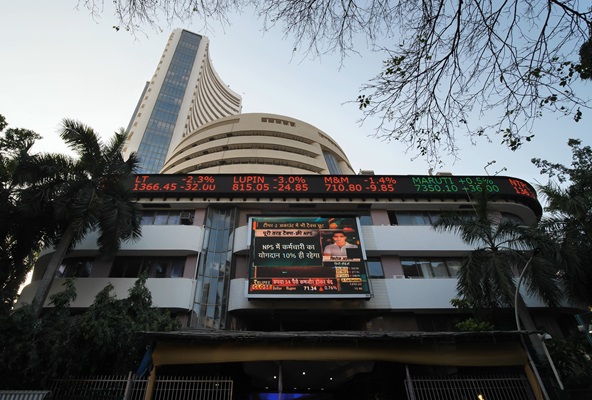.png)

Dhananjay Sinha, CEO and Co-Head of Institutional Equities at Systematix Group, has over 25 years of experience in macroeconomics, strategy, and equity research. A prolific writer, Dhananjay is known for his data-driven views on markets, sectors, and cycles.
August 25, 2025 at 3:31 AM IST
As India navigates the second half of 2025, its financial markets are caught in a balancing act—grappling with the global fallout of renewed US protectionism, domestic stimulus expectations, and persistent structural headwinds. The interplay of these forces is reshaping investor sentiment, corporate performance, and policy priorities, with implications that extend far beyond headline GDP figures.
The re-emergence of ultra-protectionist trade policies under Trump 2.0 has upended assumptions about India’s strategic insulation. The cumulative tariff burden on Indian exports has surged to 50%, including penalties linked to Russia trade, dismantling the once-popular “TACO” thesis, where India was expected to benefit from softer US trade terms due to geopolitical alignment.
Instead, India now finds itself in the crosshairs of a broader tariff war, with limited room for negotiation. Historical parallels with the 2019 US-China trade war are instructive: despite not being a direct party, India’s GDP growth then fell sharply, trade contracted, and equity markets slumped.
Today’s scenario is arguably more complex, with synchronous tariff actions threatening global financial stability and forcing India to recalibrate its trade alliances, pivoting eastward toward China and Russia.
Corporate vs Macros
The disconnect between macro aggregates and microeconomic realities is becoming increasingly stark. While real GDP growth clocked a robust 7.4% in January-March and is projected at 6.5% for 2025-26, corporate earnings tell a different story. Non-financial sales growth decelerated to just 3.9% in April-June, and banking sector credit growth halved year-on-year. Companies have responded by trimming operating costs to preserve margins, but the underlying demand weakness remains unresolved.
This divergence raises critical questions about the sustainability of growth and the efficacy of policy responses. The June quarter results suggest that the full impact of US tariffs is yet to unfold, and early signs of stress are already visible across sectors.
Stimulus, Fiscal Trade-Offs
In response to slowing demand and weakening tax collections, the government has initiated a series of post-election policy shifts, ranging from income tax relief and employment-linked schemes to selective export support and RBI dividend utilisation. Yet, the impact has been muted. The proposed GST rate rationalisation ahead of Diwali aims to revive consumption, but it risks fiscal slippage, with estimated revenue losses of ₹700–800 billion for both the Centre and the States.
Monetary easing and relaxed retail lending norms reflect a broader policy reset, but the scale may still fall short given the intensity of global headwinds, overleveraged households and elusive corporate capex. The fiscal consolidation path remains fraught with trade-offs, especially as direct taxes contract and indirect taxes slow.
Equity markets have remained flat over the past year, underperforming bonds and witnessing a market cap erosion of ₹30 trillion, roughly 15% of household income. Sectoral performance has been uneven, with private banks and NBFCs outperforming, while Media, Real Estate, IT, PSUs, Oil & Gas, FMCG, and Capital Goods posted deep negative returns. Mid and small caps declined by 5–6%, reflecting broader investor caution.
Valuations are now below pre-COVID levels, with Nifty 50 trailing PE at 22x versus the historical average of 24x. Key valuation drivers: volatility, risk-free rates, and earnings suggest continued pressure. The CBOE VIX has moderated, but second-order effects from trade tensions could reignite volatility. India’s 10-year yield has risen to 6.5%, and earnings growth is increasingly driven by base effects.
Sectoral Pulse
- Banks: Credit growth slowed to sub 10%, driven by unsecured lending, while industrial credit weakened. NIMs contracted, prompting rate cuts on deposits. Stress in microfinance portfolios remains a concern.
- Cement: A bright spot, with strong volume growth and profitability. Leaders like UltraTech and Ambuja benefited from pricing recovery and cost discipline.
- Metals: Faced margin pressure due to weak construction demand and monsoon disruptions, though select players like Jindal Steel outperformed.
- Autos: Domestic volumes declined 6% year-over-year, with two-wheelers down 8%. Rising input costs and export uncertainties weigh on the outlook, though utility vehicles and tractors showed resilience.
- Consumer Staples: Posted 6.5% revenue growth, supported by rural demand. Volume growth may improve in the second half of 2025-26 amid easing inflation and potential GST cuts.
- IT: Mixed performance, with tier-1 firms underperforming. Tariff headwinds and weak discretionary spending are offset partially by AI-led deals and BFSI resilience.
- Consumer Discretionary: Urban demand remains soft, but Tier 2/3 towns outperformed. Alcoholic beverages and jewellery retailers posted strong gains, while QSRs struggled.
- Textiles: Tariff threats erode competitiveness, despite solid export growth. Relief depends on trade negotiations and policy support.
- Pharma: Valuations corrected due to US uncertainties, but the domestic market remains resilient.
Rotation Over Narrative
In this volatile environment, alpha generation will depend less on macro narratives and more on fundamental performance. Sector rotation is likely to dominate, with investors rewarding earnings surprises and punishing disappointments. Domestic consumption plays such as autos, staples, durables, consumer discretionary, and agrochemicals could benefit from GST rationalisation and rural revival.
Conversely, reduced government capex may weigh on infrastructure and manufacturing. The termination of the GST Compensation Cess after March 2026 could be a trigger for select sectors, particularly the passenger vehicle industry. To offset revenue shortfalls, the next budget may lean toward a “tax the rich” philosophy, adding another layer of complexity to the investment landscape.
The Teflon of strategic optimism no longer shields India’s markets. As global trade dynamics shift and domestic policy recalibrates, investors must navigate a landscape defined by volatility, uneven sectoral performance, and structural trade-offs. The path forward demands not just tactical agility, but a deeper understanding of the forces reshaping India’s economic trajectory.




